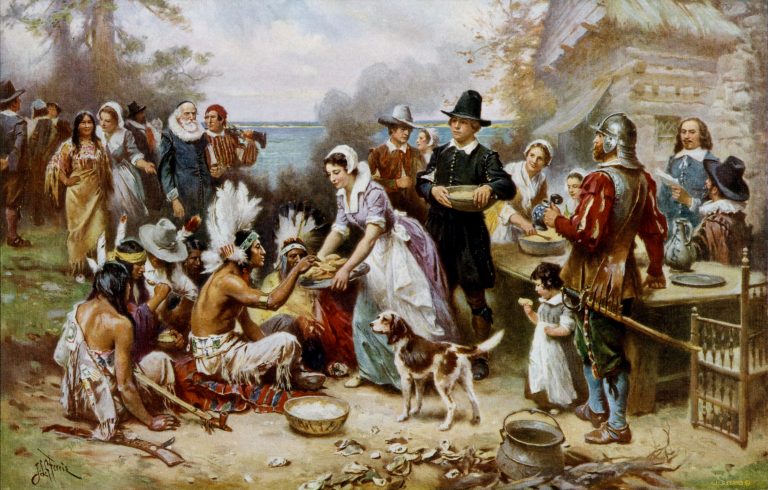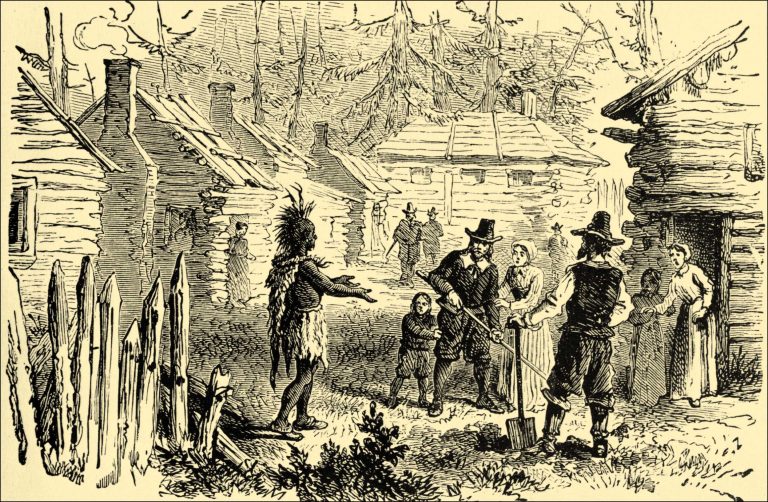Washing Down the First Thanksgiving
Before 1609, the history of the Mayflower has been lost. When a group of investors, including captain Christopher Jones, purchased the ship in 1609, it became a trading ship. Its typical day became delivering wool and other textiles to France and picking up Bordeaux wines and Cognac to bring to England. It did have a few adventures outside of that route, like the time it went to Norway to deliver hemp, hops, and hats and pick up wood and tar. That ended poorly, with the cargo being ditched to save the ship in the middle of a North Sea storm. There were a few trips to the Mediterranean as well, and one rumored adventure to the coast of Greenland for some whaling. After a run to France in 1620, Captain Jones brought the ship back to London and was hired for a different type of transportation: bringing a group of Protestant separatists to the New World.
They began to stock provisions for the long trip, including beer, wine, and “aqua-vitae”, most likely whiskey or brandy. Hops were just starting to find their way into brewing as a flavoring element in England. It was so new that the end result was referred to as an “ale” if it did not have hops in it, and “beer” if it was hopped. This was an important element of the trip. We may think that the Puritans did not drink, but they loved their liquor. Many of the writings about arriving in the New World revolved around lamentations concerning the lack of taverns to welcome them after the long journey.
The trip overseas was a rough one. So rough, that one of the main masts broke. There was a serious discussion on turning back to England and calling it off. They were able to fix it with the help of tools that were brought for the new intended settlement near the Hudson River, at that point considered part of Virginia. Including the crew, over one hundred and thirty passengers set sail. Most of them made it to Cape Cod, where a rough sea and impending winter made them stop there. They set foot on land on November 11, with Captain Jones leading the way.
Over the next month, they made several excursions into the frozen woods, finding buried pots of beans and corn used to supplement their dwindling rations. They got lost on their first excursion, forced to spend the freezing cold night with a makeshift shelter, their “victuals” being “only biscuit and Holland cheese, and a little bottle of aquavitae.” It is fortunate for them they did not encounter anything more deadly than the cold and snow. The local tribesmen, part of the Wampanoag Confederacy, would not have been pleased to find their stored food for spring had been raided. They were looking for the best place to start a settlement in this chilly landscape. By Christmas of 1620, they had decided on Plymouth for their colony and started to build.
The general disdain for water that the British had was cultural. In England, only the poorest of people drank water. Even middle class workers could afford beer, cider, or at the very least milk and tea. People that could afford beer drank it because it was safer than the water, especially in cities. This was well before landfills, recycling, and water treatment. Anything that was dumped in the street or thrown out the window could end up in the local water source. The sources of water in the New World were considerably cleaner than the ones in London. One even wrote that it could be considered a suitable replacement for the beer or wine. Those sources were still not spotless. Sickness was starting to creep into the ranks of the settlers, as well as the crew of the Mayflower.
Illness and rough seas kept the ship anchored there until April of 1621, when the crew sailed for home port. On the ship, there was only beer, and the crew was going to protect that for the journey home. Even with so many sick men and women on the ship, settlers were allowed water only. Sailors went as far as to declare that when Protestant leader William Bradford asked for beer, “it was answered that if he was their own father he should have none.”
Though half of their number died in that hard winter, they were able to start planting the crops they brought along with them. The Wampanoag helped them with their planting, introducing them to some of the edible native plants in the area. The tribe aided in hunting and fishing, expanding the diets of the Protestants and keeping them alive through the harvest. Fortunately for the English, one of the fruits they were provided were apples. Without barley or any other grains to spare for brewing, and with their initial stocks of liquor long gone, hard cider became a staple drink. It was relatively weak, clocking in around 2-4% ABV, but it was something other than water or tea.
Water and tea were the two things the Wampanoag enjoyed drinking. There is some debate, but by and large there is no evidence that northern tribes drank alcohol until it was introduced by colonists. Tribes in what is now the southwest United States and all of Mexico enjoyed a variety of fermented beverages, like pulque (a wine made from the agave plant) and tiswin (beer made from corn). There are some mentions of large pots of wine that tribes drank from, but if it was fermented it was accidental. No technology was available to prevent the fermentation process from happening, so low levels of alcohol were most likely present. There is some mention that tribes in Georgia and other southern states fermented beverages, possibly due to a climate more conducive to the process.
By harvest time they had settled in with with new neighbors, and were planning on having a feast to celebrate their first successful, but meager, harvest. They invited the Wampanoag to the feast, which lasted for three days. In addition to what the settlers provided, which involved local birds, wheat, peas, and corn, the tribe brought clams, mussels, raspberries, strawberries, local nuts, and at least five deer. There is no record of it, but it is thought there was three to five gallons of cider provided by the Protestants to drink. Or about as much as my family may go through on Thanksgiving Day.
Want to replicate what the Pilgrims could have enjoyed at their feast? Hard ciders are where to start. Try sips like Adirondack Brewery Farmhouse Craft Hard Cider (Silver Medalist of the 2021 New York International Cider Competition). , Strongbow Gold Apple (Silver Medalist at the 2016 New York International Beer Competition), Original Sin Extra Dry or any other cider on the drier side. With the settlers having very little sugar on hand, the naturally fermented cider would have been dry to our tastes. Most American ciders are going to have some sugar added. For those who would rather reach for a beer, go for something with a low ABV and low IBU to last the
meal. Fuller’s London Pride would be an excellent consideration for the table with its malty backbone and light hoppiness. Goose Island Honkers Ale is a high quality English bitter that offers a malty/hoppy balance. And I cannot ignore the Pilgrim’s hometown brewer, Mayflower Brewing Company, and their Golden Ale that would be a great addition for craft and non-craft beer drinkers alike. When in Plymouth, right?
Sitting down with close family and friends, for any reason, is an occasion to be thankful. Towards the end of any year is a good time to sit back and reflect about what the year has brought to you, taken out of you, and how you are going to build on both of those experiences. As you get ready to dine with those near and dear, bask in the warmth of the season. Remember the hardships that the Pilgrims experienced to get to their new home, and how these two different groups of people came together in friendship over a meal. Happy Thanksgiving!




